NGC 7000 with the William Optics SpaceCat 51 APO Refractor
We finally had a clear night. The only problem was the moon rising around 8:30 pm. I still had an hour of darkness before that, and used it to run some tests with my new William Optics SpaceCat 51 APO Refractor (250mm FL, f/4.9). I was already impressed by the build quality and design characteristics of this extremely portable, wide-field scope. The edge-to-edge sharpness of the images I shot during some daylight testing astounded me. So I was not surprised that my first shots of nebulae with this small but versatile refractor were beautiful. William Yang and the team at William Optics continue to innovate, creating new and more capable telescopes, while advancing and adapting their existing product lines for new and more demanding uses (Have you seen the new Fluorostar 156? Holy Zeus doing jumping-jacks, that's a beautiful refractor). The SpaceCat 51 (the limited edition space grey version of the RedCat 51) is my third William Optics scope--I started with a GT81, and I'm certain there will be more as time goes by.
Here's a stack of 10 subs of NGC 7000, North America Nebula in Cygnus, with a bit of the surrounding region including the Pelican Nebula. This is 10 x 240 second exposures stacked in DSS--no calibration frames, shot with a William Optics SpaceCat 51, ZWO ASI1600MM-Pro mono camera, and Astronomik 6nm Hydrogen-alpha filter. I'm using an Orion Thin Off-axis Guider and ZWO ASI120M-mini with this train, and guiding was spectacular. I didn't crop or do anything crazy with this stack, just normal processing in Photoshop CC 2019.
NGC 7000 (North America Nebula), IC 5070 (Pelican Nebula) and IC 5068 (lower right) are all part of the same HII region in the constellation Cygnus. NGC 7000 is about 2600 lightyears away in the Orion Arm of our the Milky Way. With this field of view, we can see over 140 trillion miles of clouds of interstellar ionized hydrogen, lit by the massive binary star HD 199579, located approximately where Chicago would be. The dark bands and filaments of dust in front of these vast glowing clouds (LDN 935, B 352, 356) help form the eponymous North America shape, blocking out a large region for the "Gulf of Mexico", running up the "East Coast" and across the "Northeast Passage".
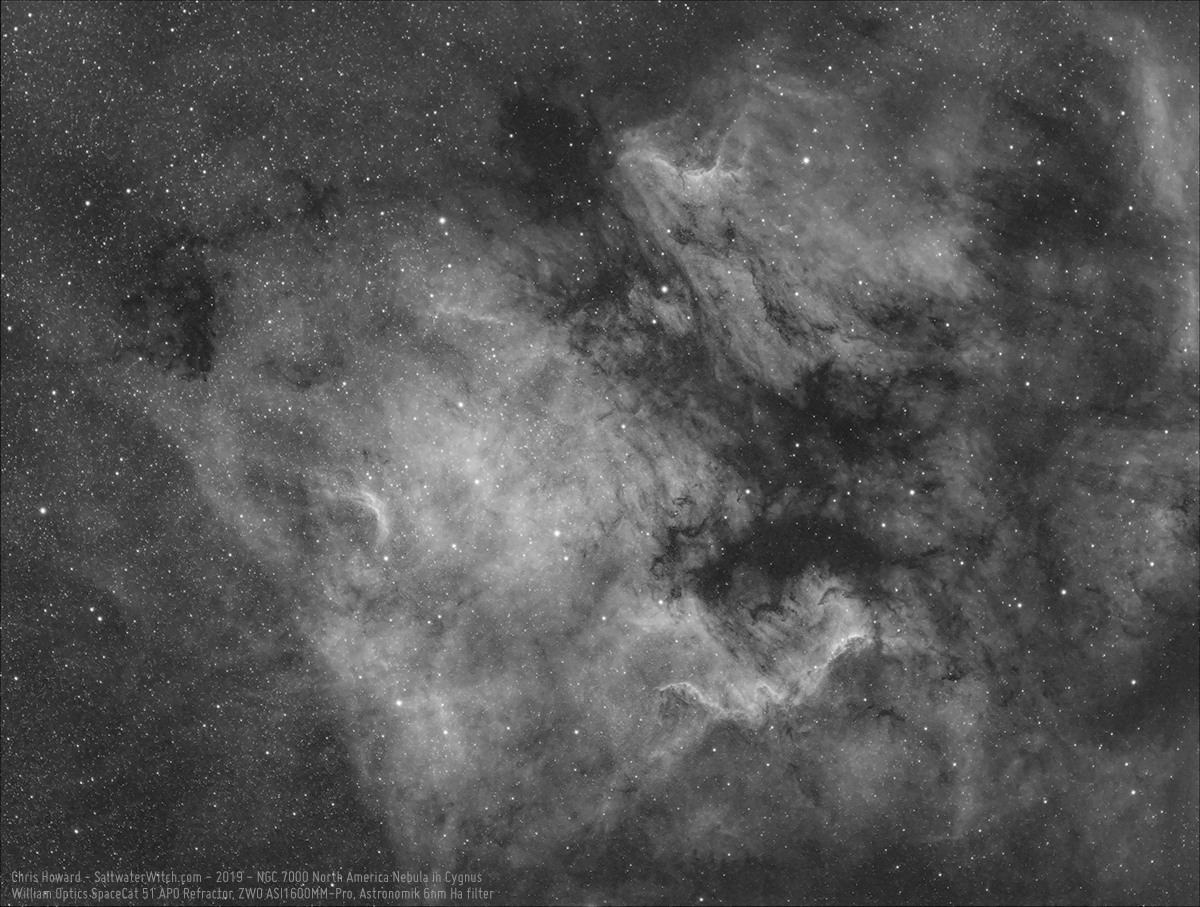
Posted October 16, 2019
Not the best night for astrophotography...
I took a 1-sec exposure of the William Optics SpaceCat 51 during some narrowband subs. There's a beautiful moon out there, but that's not great for taking shots of deep sky objects.
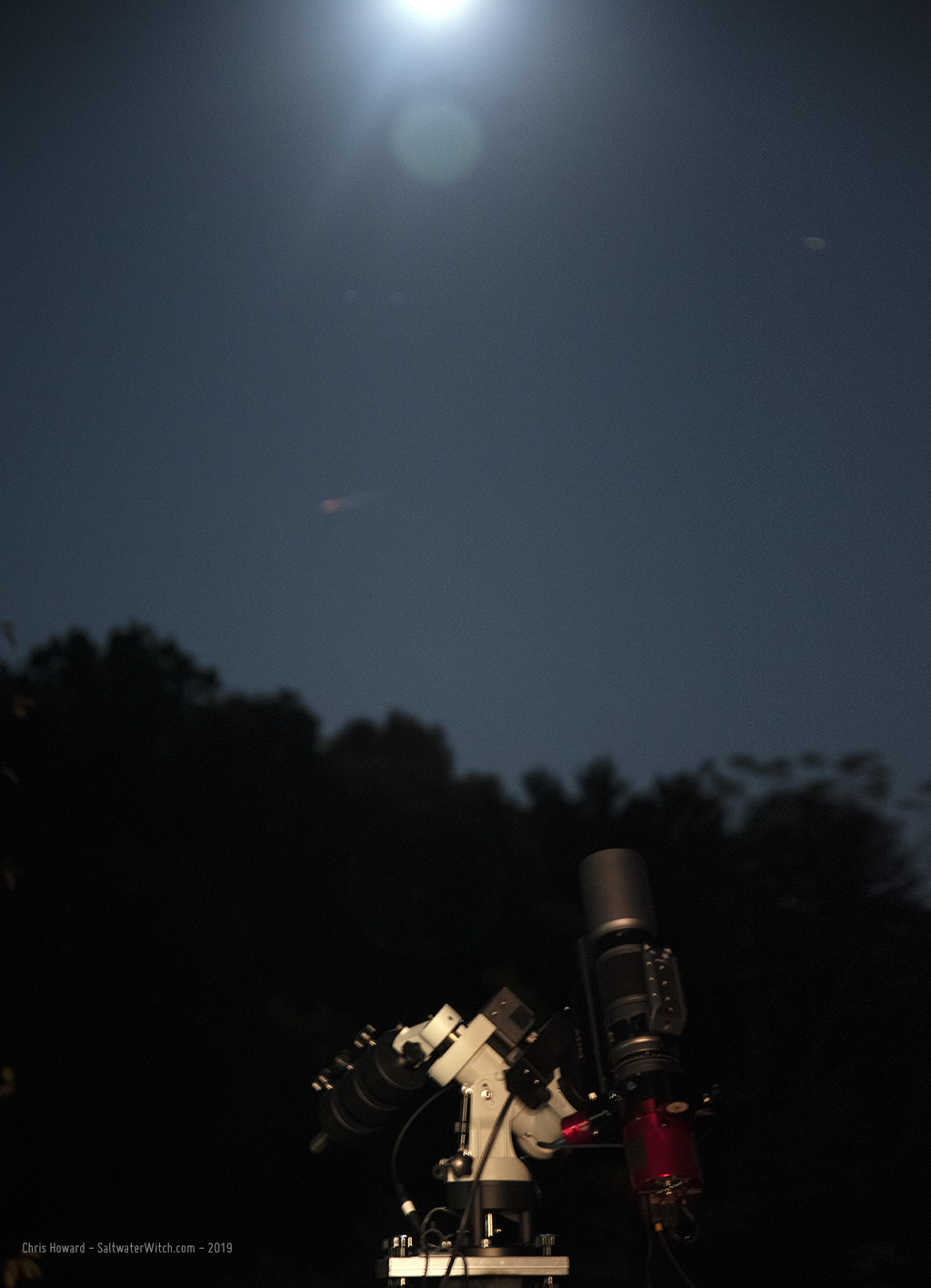
Posted October 15, 2019
Back up, see if you can get M33 in...
I didn't have much time last night, so I just went with the Nikon D750 + 70-300mm lens on the iOptron SkyGuider Pro. And shot 20 exposures of M31. I was actually just wheeling the camera around the sky, adjusting focus at 70mm when I saw Andromeda Galaxy in the upper left, and there was M33 Triangulum in the lower corner. This is cropped from the full image, and I probably could have framed these better, but I didn't feel like pushing my luck. M33 was down by the bottom edge. So I went with this, 20 stacked frames in DSS:
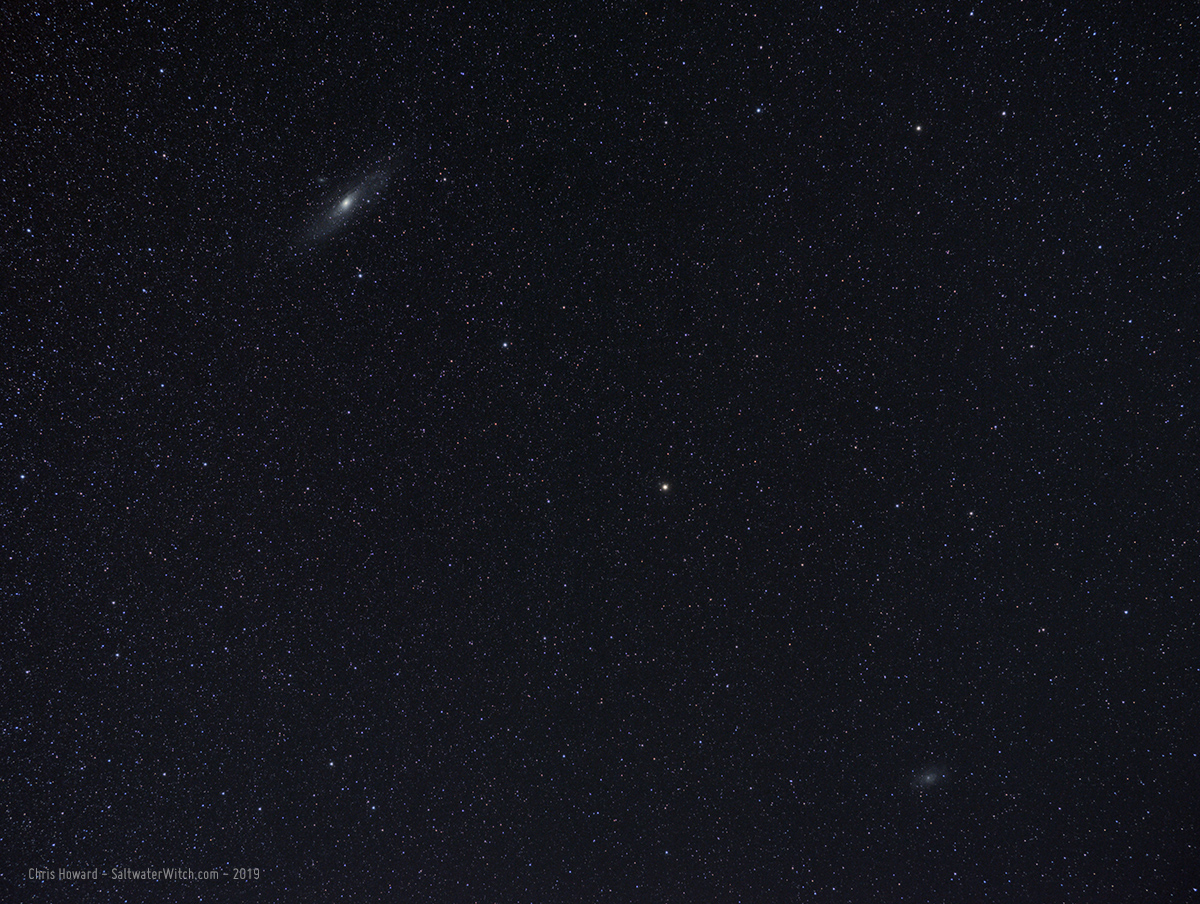
And then a little later I shot 51 25 second shots of M45, the Pleiades--this time at 300mm:
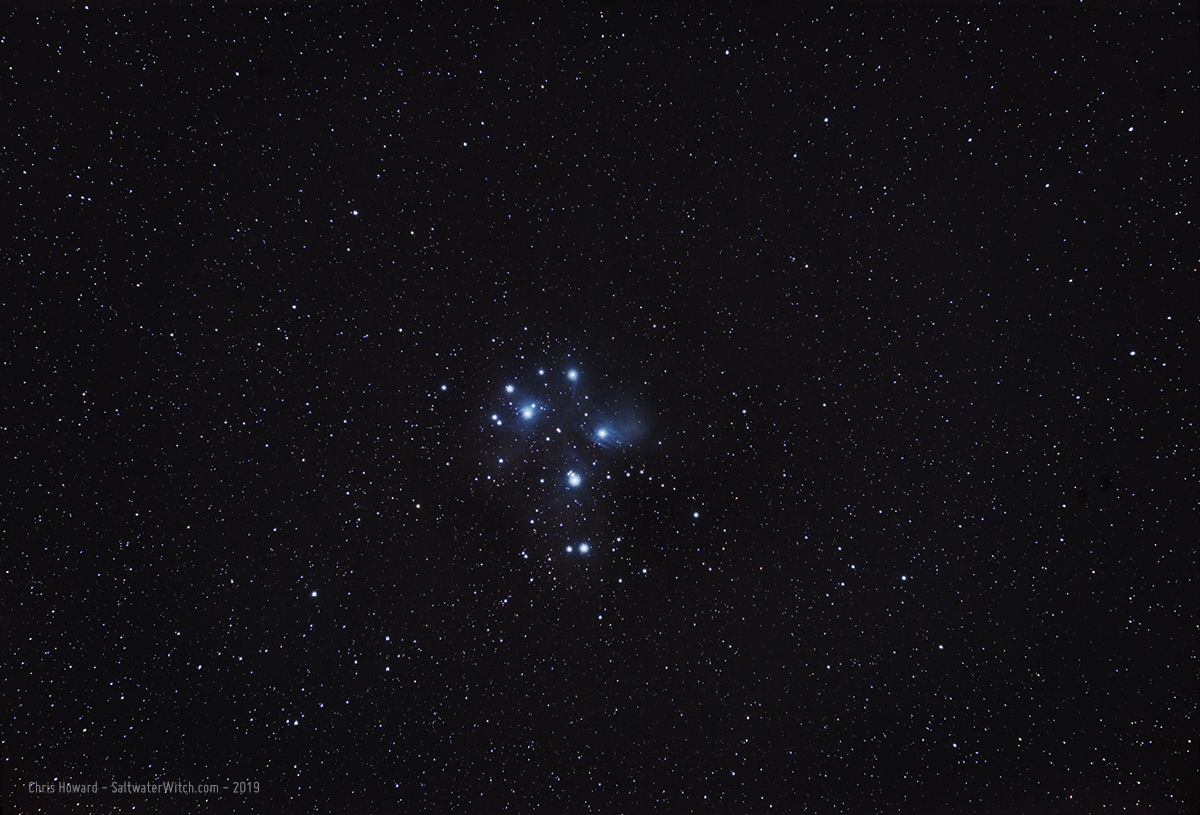
Posted October 5, 2019
M31 Andromeda off the red end of the spectrum
The Andromeda Galaxy (M31) is our largest and most magnificent galactic neighbor, about 2.5 million light-years away from earth (or 780 kiloparsecs if you're of a more serious demeanor). Here's my bi-color version in near-IR and hydrogen-alpha. With a 685nm IR longpass filter I have managed to get a ring in M110 (NGC 205) the dwarf elliptical galaxy and satellite of Andromeda (center bottom). Wasn't expecting that. I am assuming the rings are an artifact of processing or cut-out gaps between bandpasses in the filtering because M110 is an elliptical galaxy, which are evenly distributed bundles of stars without arms or distinguishable belts like a spiral galaxy, e.g., M31, Milky Way.
Anyway, I'm enjoying the variation I'm getting with infrared imaging. More on the way! I may upgrade to the Astrodon Sloan Gen2 i’ (695 - 844nm) near IR filter at some point, but I'm happy so far with the results of the less expensive Optolong 685nm.

M31 in color, one my images from early this year:
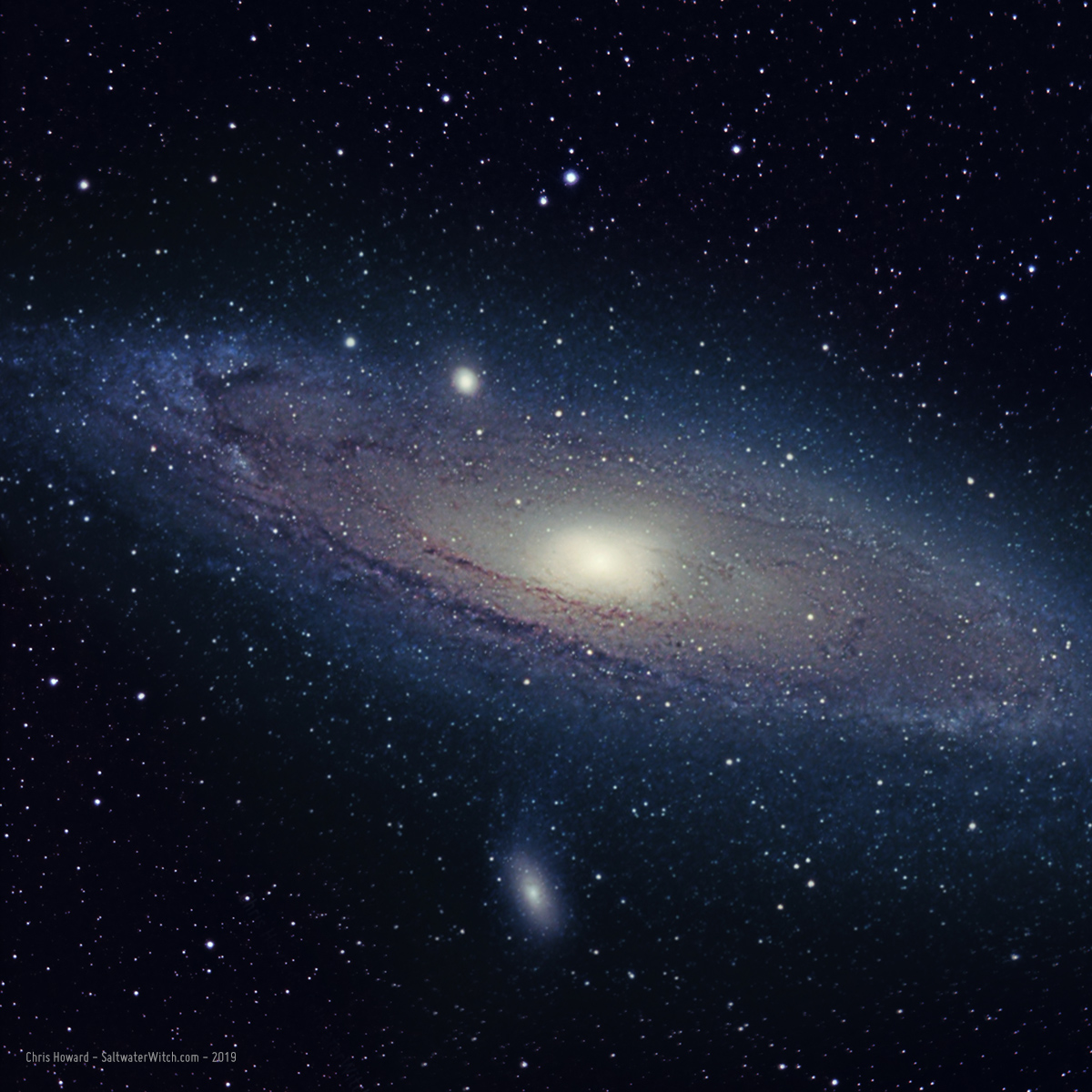
Posted September 30, 2019
Orion Nebula (M42) in the SHO Hubble Palette
I have been thinking about how to represent false-color imaging for deep sky objects, and I've been keeping more of that abundant hydrogen green in the mix when doing SHO Hubble Palette images, where we map Sulfur, Hydrogen, and Oxygen bandpasses to Red Green Blue (RGB). Because hydrogen is--by a wide margin--the most abundant element in the universe, and many of these nebulae are HII Regions (vast expanses of interstellar ionized hydrogen), there ought to be more green in SHO images than we normally see. It's become standard to go heavy on a rust red and deep blue, with most of the green removed. All of these color choices are esthetic choices. The images I'm posting come from the data from three separate filters, Ha, OIII, and SII, so in a sense there are no incorrect color levels--within reason.
You do see a lot of color (LRGB) imaging with a target like M42, and with corresponding heavy reds and browns of bandpasses on the red end of the spectrum--and heading off into infrared. Most of my shots of Orion Nebula from past years has been in RGB with a luminance layer.
In the first set I toned the hydrogen green way down--actually all the colors are lower--until I'm just getting a nice green cast over everything.
I expanded on this in an Astrobin comment, dropping it here:
I'm going to reprocess data for some recent targets, see how they turn out. I think the reasoning is sound--that we should see more green with SHO, but we'll have to see how the images look. I know many handle this already by going with HSO to map Ha to Red, which makes a lot of sense, closer to where Ha is on the EM spectrum, even if we put sulfur in Green with this pattern. At the end of the day, though, it's still about how beautiful these images of nebulae look, and how each of us measures that beauty. It could also be that dozens of others have gone through this exact cycle with color levels and patterns and ended up back where we are today, simply because the stronger blues and reds are more appealing! I think one of the best things about this hobby/obsession is that it's data driven, and when I get new data and I try new techniques--and I like what I see, I can go back and reprocess data and try these techniques on other targets. There's something very powerful about this.
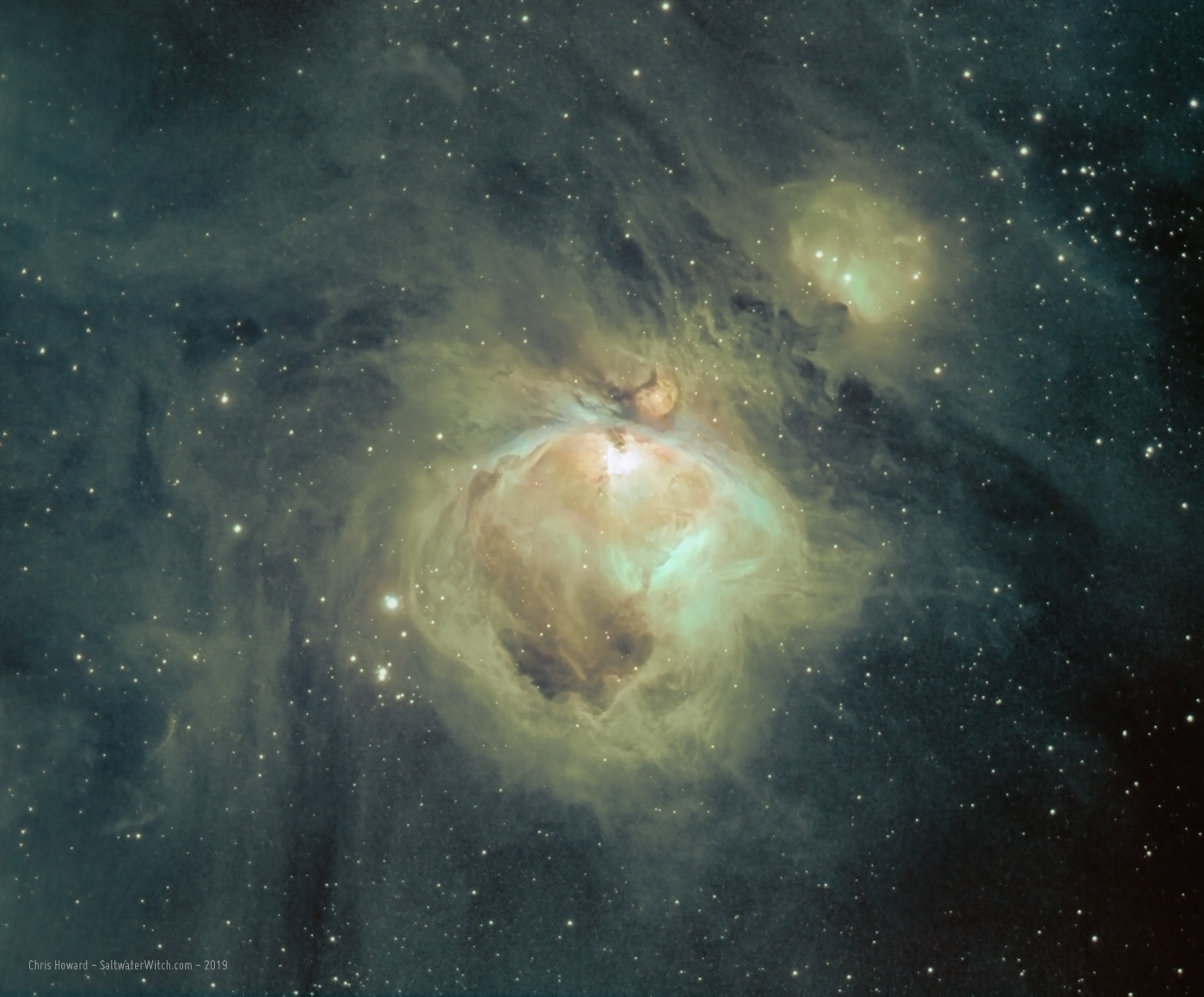
M42 Orion Nebula with the stars removed. I used the star removal in Annie's Astro Actions in Photoshop, which gets you 90% there, with some cleanup around the remnants of larger stars. Okay, this looks like H.R. Giger's version of the Orion Nebula.
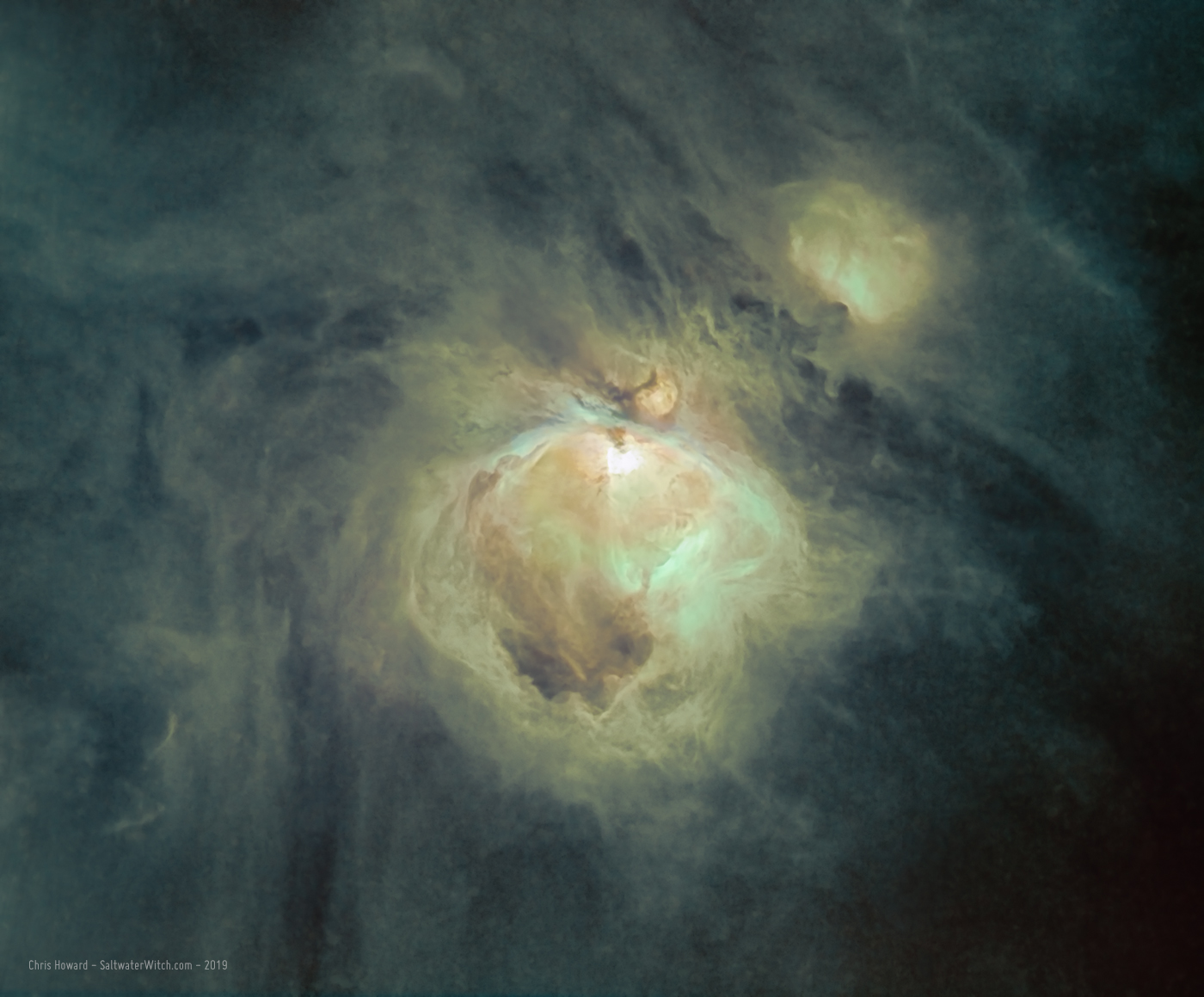
To show you what I mean by "no incorrect color levels", this is the same imaging data, from the same stacked Ha, OIII, and SII frames. I just went in a different direction with which bandpass to stress--oxygen in this case, with stronger blues. It's strange how the "running man" shape in Sh2-279 Running Man Nebula, the brightish cloud above Orion, only appears faintly in narrowband. And in Orion, on the bottom right side, there's the weird chicken leg of hydrogen that now stands out behind the wispy pale clouds that ring the nebula.
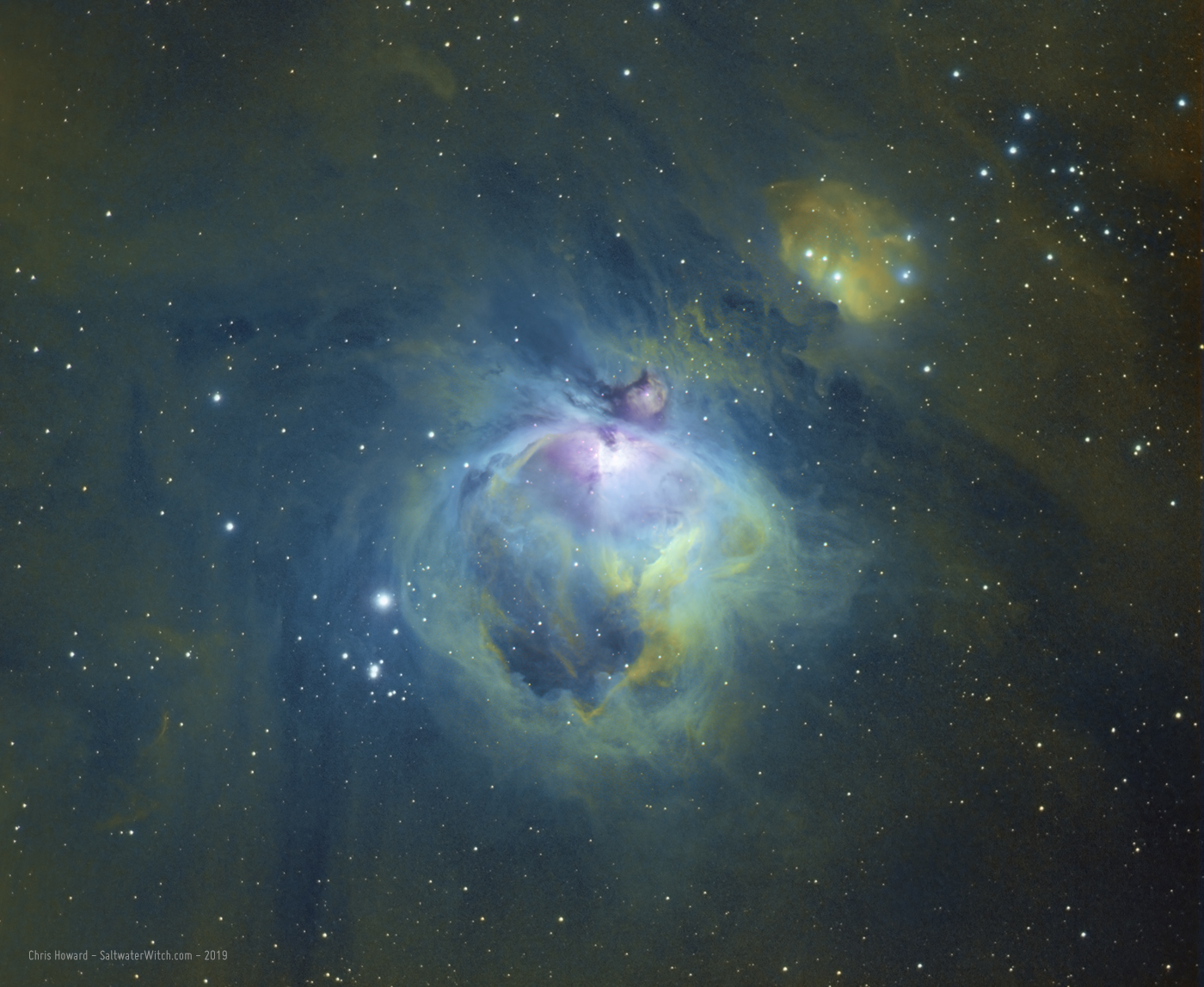
And here's the same data set in HSO, with hydrogen-alpha mapped to red in RGB, sulfur green, and oxygen blue. You could argue that this is slightly more natural, as the hydrogen-alpha line is off the red end of the visible spectrum at 656nm, just this side of infrared. Mapping Ha to red makes sense, but mapping sulfur to green doesn't. The sulfur line is also on the red end of the spectrum, which is why normal RGB images of most deep sky objects taken with a DSLR or OSC camera are usually very red.
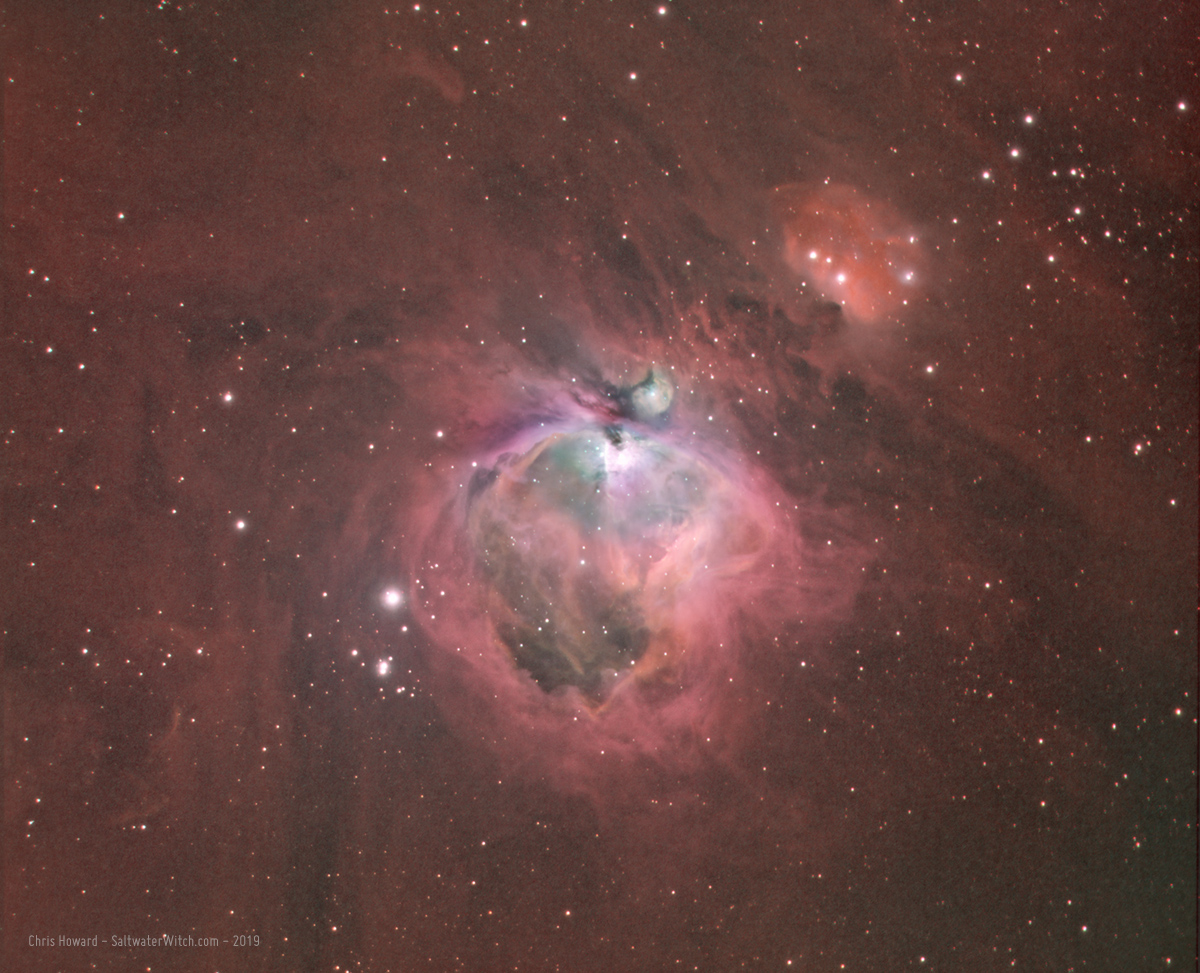
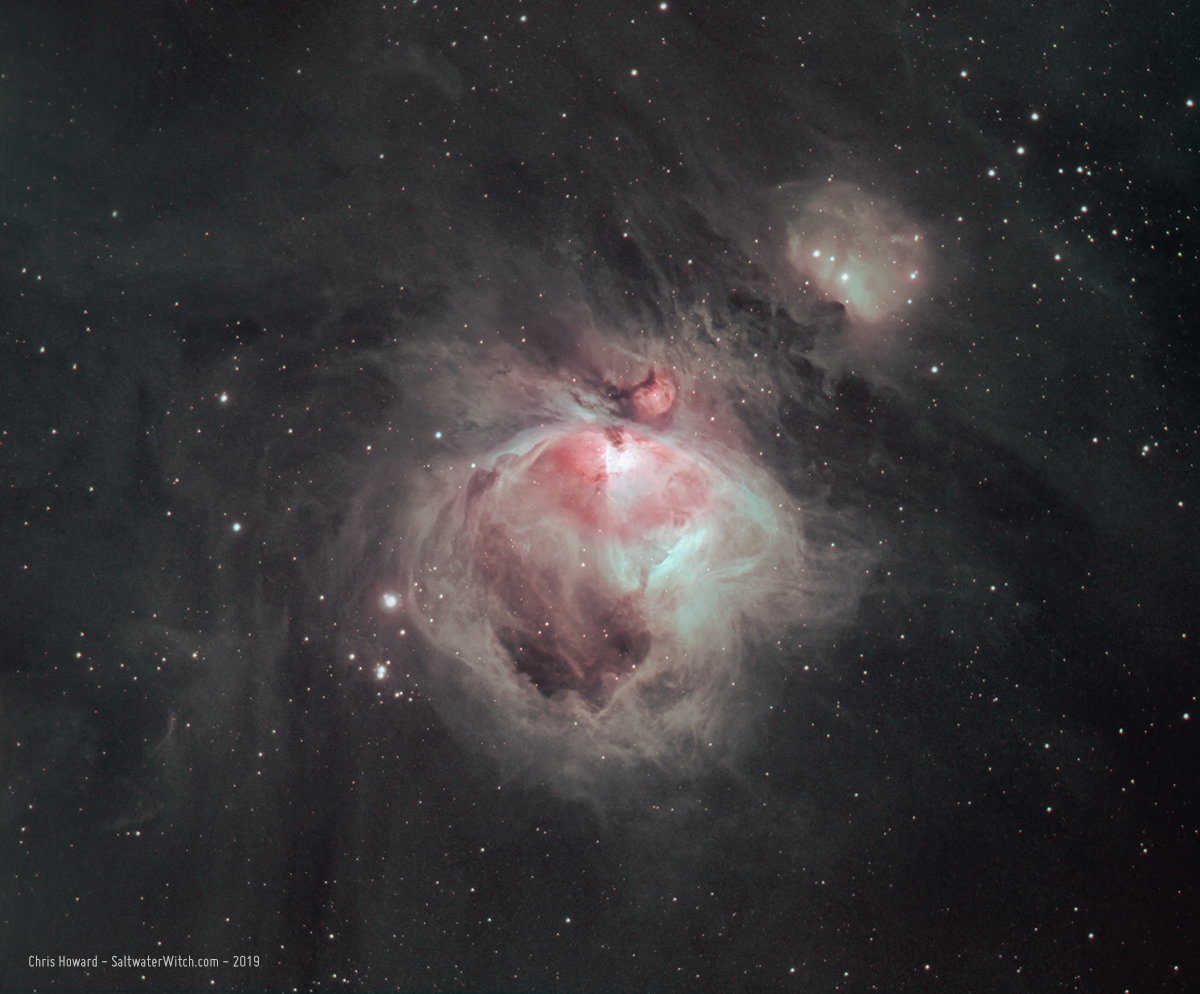
Imaging notes: William Optics GT81 at f/4.7 with WO 0.8x Flat6A II, Astronomik Ha, OIII, SII 6nm filters, Moonlite focuser, ZWO ASI120MM OAG, Imaging camera: ZWO ASI1600MM Pro cooled mono on an Orion Atlas EQ-G mount. Stacked in DSS, processed in PS CC 2019. 40 x 120 second exposures for each filter.
Posted September 29, 2019
High-gain Test - Gathering Narrowband Data
Autumn is officially here, and this is the season of the Pleiades, Orion, the nebulae in the constellations of Perseus, Monoceros, Auriga, Taurus, and Gemini. Now, M42 isn't in view until 2am, so that had to be the last in the sequence. And, yes, you can tell I was just dorking around with filters with our galactic neighbor, Andromeda M31, in near IR and hydrogen-alpha. I know M31 is a decent Ha target, and you can see some wonderful images in Ha-RGB out there in the world, but I had never tried shooting 2-minute subs of M31 with a 685nm long pass filter.
I ran the ZWO ASI1600MM-Pro mono CMOS camera at a gain of 200 and offset of 65 in the following shots. And no calibration frames for any of these. Higher gain reduces dynamic range, but you're also reducing read noise and gaining (ha ha) resolution and the ability to shoot shorter exposures--and more of them, and if you take enough subs, this should balance things out. There are miles of discussion on gain and offset in astro-imaging, but I was recently reading Jon Rista's comments in an astrobin forum thread and that got me to test out higher gain/offset.
M31 in Near-IR + Ha

I moved over to Cassiopeia and shot 40 x 4-minute subs each of IC 1805 (Heart Nebula) and IC 1848 (Soul Nebula) in Hydrogen-alpha. Here's the stitched together pair:
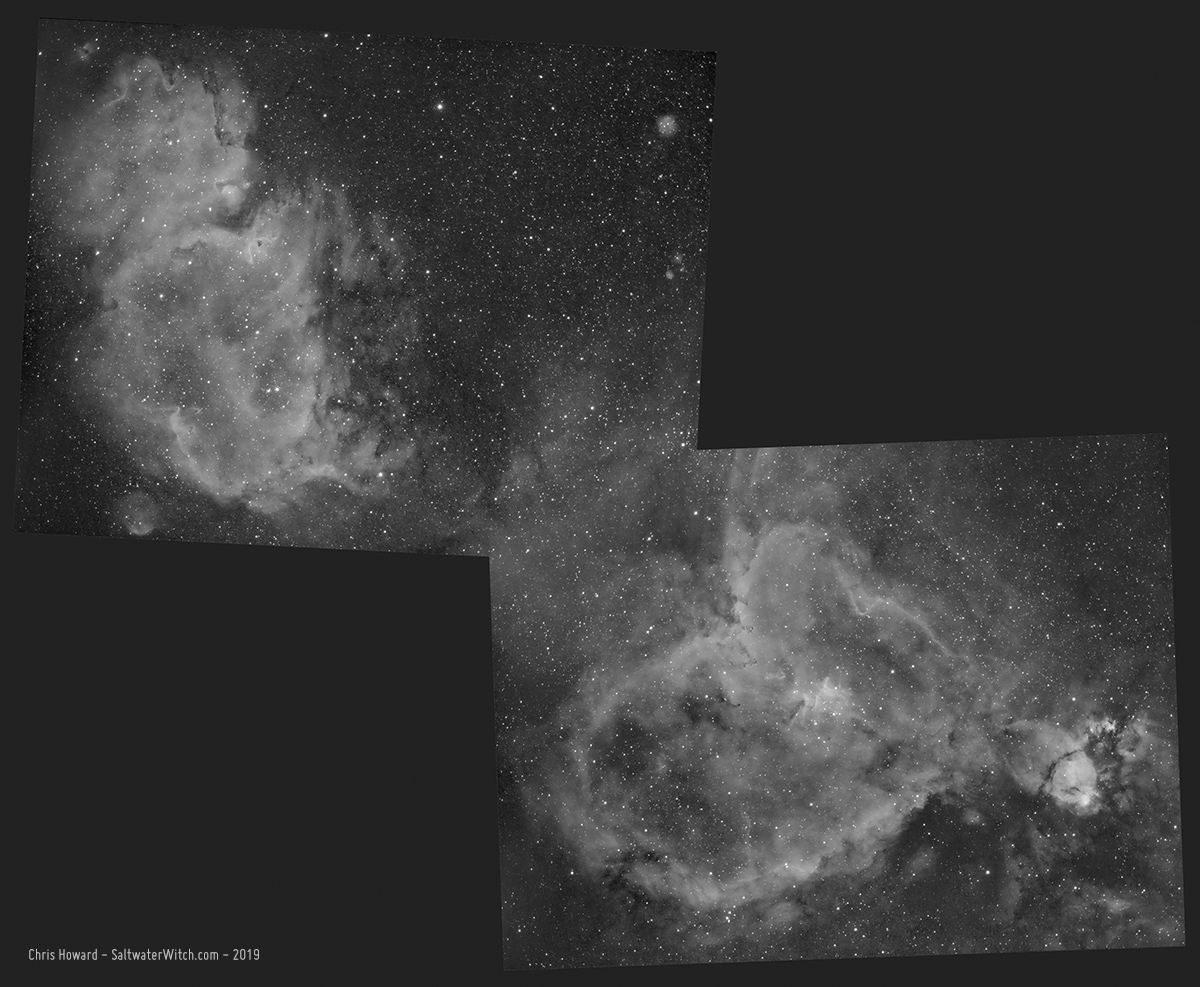
Still waiting for Orion to get above 30°, I spent some time on NGC 1499 "California Nebula"
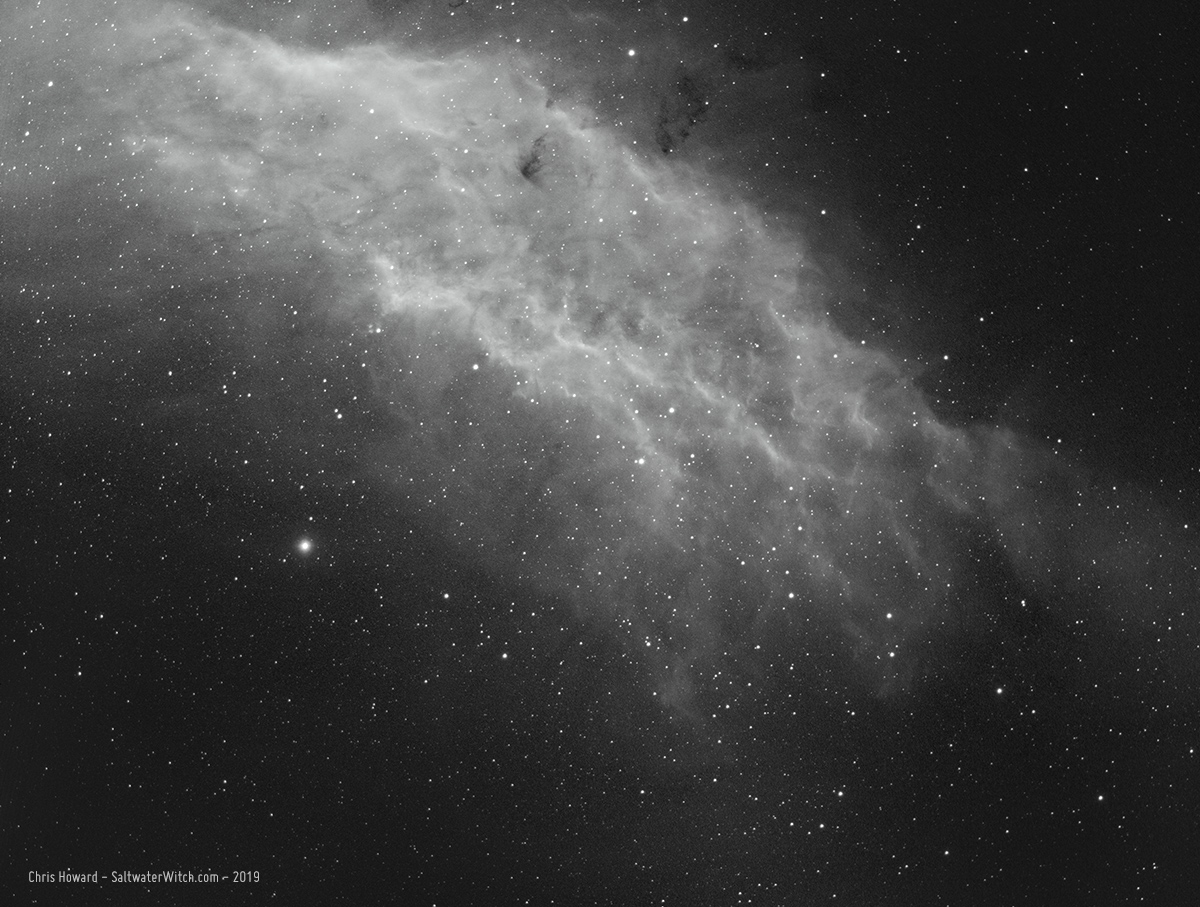
And Orion is back in the sky! Sure, you have to get up at 3 in the freakin' morning to see it with your own eyes. Or you can program your astro imaging system to stay up all night and take pictures without you. Here's M42, Orion Nebula, along with M43, De Mairan's Nebula--that's the spherical-looking cloud formation with the big bite taken out of it. And above that, shining brightly, Sh2-279 Running Man Nebula--although the famous running man shape isn't clear in hydrogen alpha. I'm not sure how well it comes out with oxygen III and sulfur II, but I'll come back another night to capture the OIII and SII frames. Notes: 31 x 240 second exposures in Ha + 20x 10 second subs just for the Trapezium (the super bright core of the Orion Nebula--so bright I have to take separate short exposure shots and merge it back in processing). William Optics GT81 APO refractor, ZWO ASI1600MM-Pro mono camera, Astronomik 6nm Ha filter.
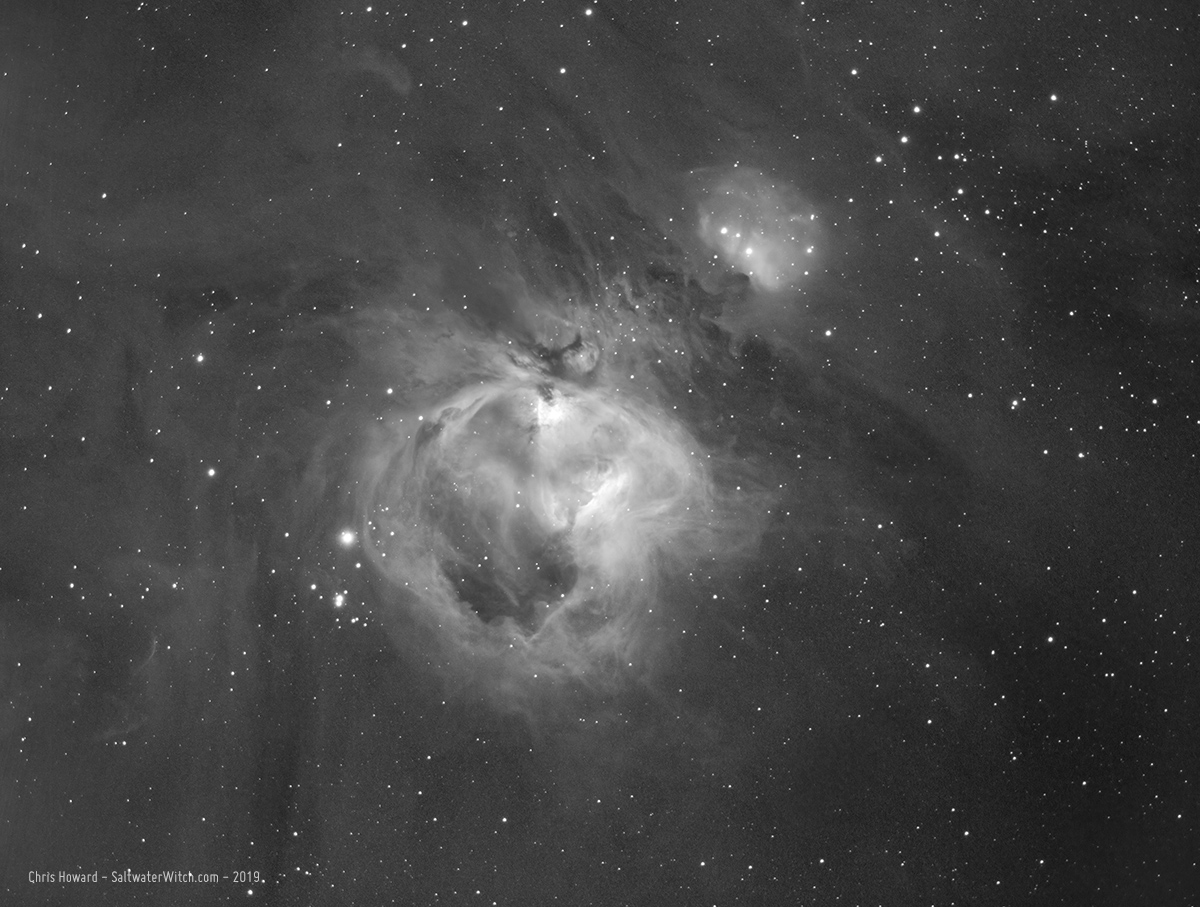
Posted September 26, 2019
Very wide-angle view of the sky
Here's my first night out with the Irix 15mm f/2.4 Blackstone (the heavier, more durable, aluminum and magnesium alloy housing version of this lens). And I'm impressed with just a few shots, wide-open aperture, and single 15 - 20 second exposures--no tripod, although I rested the Nikon on the deck railing.




Posted August 31, 2019
iOptron SkyGuider Pro Test 2
Cygnus region of the Milky Way, with NGC 7000 North America nebula at the bottom left, the Sadr Region in the center, and it's crazy how much of the Veil Nebula showed up--that's the ring of wispy, mostly white nebulosity on the right toward the bottom. The reddish/pinkish areas are mostly clouds of hydrogen gas, while the pale cloudy areas are mostly stars--so many stars. Our galaxy contains somewhere between 150 and 250 BILLION stars. 3 x 120 sec exposures, Nikon D750 85mm f/5.6, on an iOptron SkyGuider Pro tracker.
The SkyGuider Pro has iOptron's standard polar scope and reticle, and by "standard" I mean so much easier to use than just about any other polar scope on the market--that I've used anyway. With just a simple alignment, using the SkyGuider's polar scope, I was shooting 2 and 3 minute exposures. This little tracker is amazingly simple and powerful. At some point I will start testing my color wide-field rig with the William Optics ZS61 and ZWO ASI071MC camera, but for now I want to get used to the SkyGuider, and I'm using my good old Nikon D750 full frame DSLR (unmodified). And you can see this setup produced some decent images to stack.

